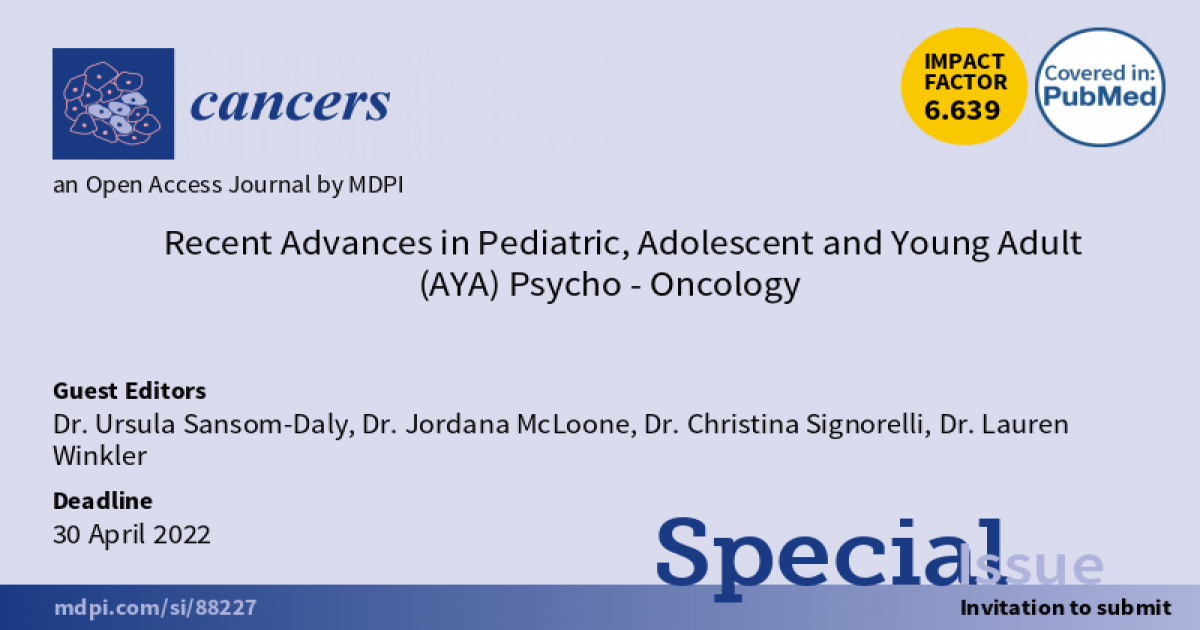Recent Advances in Pediatric, Adolescent and Young Adult (AYA) Psycho-Oncology
A special issue of Cancers (ISSN 2072-6694). This special issue belongs to the section "Pediatric Oncology".
Deadline for manuscript submissions: closed (30 April 2022) | Viewed by 52584

Special Issue Editors
Interests: adolescent and young adult (AYA) oncology; paediatric oncology; clinical psychology; interventions; telehealth and e-health; mental health; cancer survivorship; implementation science
Interests: childhood cancer; survivors; paediatric oncology; telehealth; e-health; child health; oncology; cancer survivorship; paediatric; models of care; implementation science; qualitative
Interests: childhood cancer; survivors; paediatric oncology; telehealth; e-health; child health; oncology; cancer survivorship; paediatric; models of care; implementation science; qualitative methods; patient education; health behaviours; interventions
Interests: childhood cancer; survivors; paediatric oncology; health behaviours; nutrition; parent interventions; implementation science; e-health
Special Issue Information
Dear Colleagues,
Pediatric oncology has enjoyed great success over the past several decades. Cure is the most likely outcome for a child, adolescent, or young adult (AYA) diagnosed with cancer. Nevertheless, these medical gains bring with them new challenges that young survivors and their families must face. For many young people, the impact of their cancer and its treatment can lead to decades of physical, functional, and mental health concerns that last well into adulthood, with a tremendous psychosocial impact. A subset of young people are particularly vulnerable, including those with rare, hereditary, or poor-prognosis cancers, or those treated with novel and/or targeted therapies, for whom the terms ‘remission’, ‘cure’, ‘survival’, and ‘prognosis’ each carry with them significant uncertainty during and beyond treatment.
It is vital that the pediatric/AYA psycho-oncology field continues to harness the most rigorous scientific methods, driven by patient and clinician needs and novel intervention approaches to optimise patient care. Moving forward, approaches that draw on the principles of implementation science and research translation will help to ensure that gains made in academia translate to rapid improvements to patient care. For this Special Issue, we welcome original and review papers addressing challenges and recent advances in paediatric/AYA psycho-oncology across the cancer trajectory, from diagnosis through to survivorship and end-of-life. We especially seek papers that provide insight into new research methodologies, intervention approaches, and adaptations to psycho-oncology models of care and interventions to enhance outcomes for particularly vulnerable groups—whether vulnerable due to their ongoing medical challenges (including rare, high-risk, and poor-prognosis cancers), socio-economic factors, or other psychosocial and mental health vulnerabilities. Papers that demonstrate attention to consumer/stakeholder engagement, research translation, and implementation science will be particularly valued.
Dr. Ursula Sansom-Daly
Dr. Jordana McLoone
Dr. Christina Signorelli
Dr. Lauren Winkler
Guest Editors
Manuscript Submission Information
Manuscripts should be submitted online at www.mdpi.com by registering and logging in to this website. Once you are registered, click here to go to the submission form. Manuscripts can be submitted until the deadline. All submissions that pass pre-check are peer-reviewed. Accepted papers will be published continuously in the journal (as soon as accepted) and will be listed together on the special issue website. Research articles, review articles as well as communications are invited. For planned papers, a title and short abstract (about 100 words) can be sent to the Editorial Office for announcement on this website.
Submitted manuscripts should not have been published previously, nor be under consideration for publication elsewhere (except conference proceedings papers). All manuscripts are thoroughly refereed through a single-blind peer-review process. A guide for authors and other relevant information for submission of manuscripts is available on the Instructions for Authors page. Cancers is an international peer-reviewed open access semimonthly journal published by MDPI.
Please visit the Instructions for Authors page before submitting a manuscript. The Article Processing Charge (APC) for publication in this open access journal is 2900 CHF (Swiss Francs). Submitted papers should be well formatted and use good English. Authors may use MDPI's English editing service prior to publication or during author revisions.
Keywords
- childhood cancer
- adolescents and young adults
- survivors
- interventions
- telehealth
- psychosocial
- mental health
- palliative care
- vulnerable groups
- research translation
- implementation research
Benefits of Publishing in a Special Issue
- Ease of navigation: Grouping papers by topic helps scholars navigate broad scope journals more efficiently.
- Greater discoverability: Special Issues support the reach and impact of scientific research. Articles in Special Issues are more discoverable and cited more frequently.
- Expansion of research network: Special Issues facilitate connections among authors, fostering scientific collaborations.
- External promotion: Articles in Special Issues are often promoted through the journal's social media, increasing their visibility.
- e-Book format: Special Issues with more than 10 articles can be published as dedicated e-books, ensuring wide and rapid dissemination.
Further information on MDPI's Special Issue polices can be found here.






